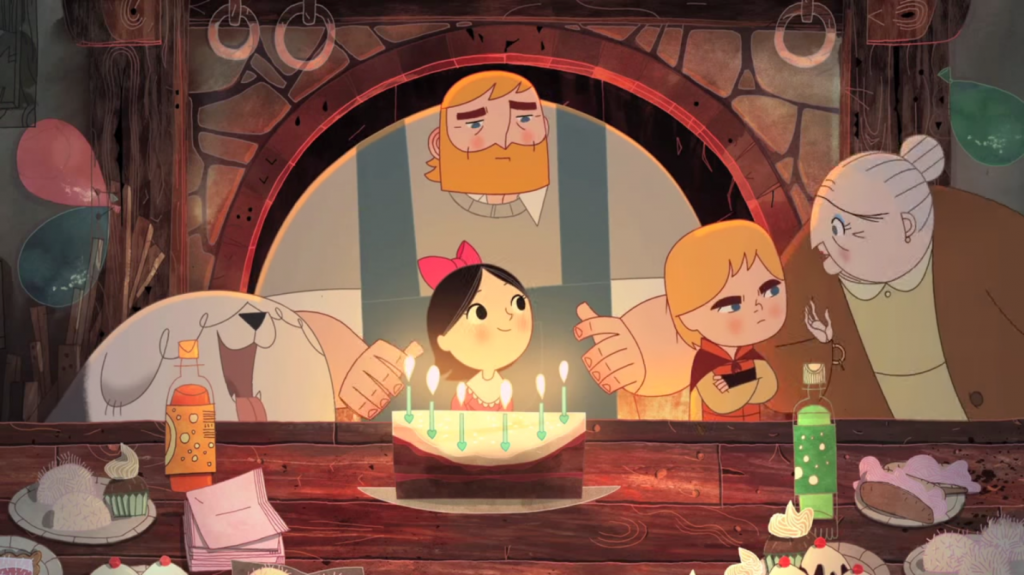01.19
Despite the freezing rain that was pouring down over the city just after the new year began, I ultimately decided to drag my ass from the North Bronx down to the Village to watch “Song of the Sea,” despite not eating anything that day. Due to some issues with the train, I ended up missing the 2:30pm showing — though I forgot how to get to IFC Center anyway — so I resolved to spend my time at the Hudson Park Library to regain my bearings and wait for the 4:30pm showing. While there, I ended up reading a manhua about suicidal depression that I first came across back in 2010, and thinking about how to strike a bond with the Engenni-speaking grandmother that just entered my life. I walked out over an hour later, back into the rain, to the art house theater to buy a ticket for the film. I waited in a line of children and adults for half-an-hour before the theater door opened and we could take our seats. Ultimately, the reason why I’m telling you all this is so you can understand my mindset going in. I was cold, hungry, and a little sad as the theater lights dimmed and the movie started playing. By the time the movie ended ninety minutes later, I was still hungry, but the coldness and sadness had been replaced by both a physical and emotional warmth that made me glad to have gone out that day. That’s “Song of the Sea” in a nutshell: a legitimately heartwarming film that aims to, if only for a second, ease and take your mind off of the emotional baggage you came to it with. Even if you have to walk ten blocks back to the train in the freezing rain afterwards.
Similar to The Secret of Kells, Tomm Moore’s previous film, Song of the Sea finds its roots in Celtic folklore, with a look at the human/seal polymorphs that are selkies this time around. In particular, the story follows a boy named Ben and his mute younger sister Saoirse, the latter of which is a selkie, as they find themselves traveling the Irish countryside to bring life back to the folktales of old. But while Kells had a more uplifting message about pursuing your dreams and aspirations, Sea‘s story of a young boy and his sister showcases the more melancholic themes of loss and grief. A husband grieves for his lost love, while his son channels his sadness into disgust and accusatory blame towards his sister. Mothers look on in sadness at their depressed sons, while an ancient spirit lives in blissful ignorance of the memories that he had loss. But despite all the melancholy, there are several moments throughout where you’ll find yourself smiling at the proceedings. There is a slow, calm progression between the emotional states that the film guides the audience through, so it never feels jarring to have a nice laugh or chuckle minutes after a tense or saddening scene. And notice that I said calm, because Song of the Sea is a very relaxed film, especially in comparison to children’s entertainment here in the Western hemisphere. When so many films strive to be loud and upfront about every aspect of themselves, there is a relief that comes with seeing a piece of cinema where “quiet moments” that allow the audience to think and take in the atmosphere aren’t a rare occurrence.
Song of the Sea utilizes watercolour backgrounds and simple, clean line art to develop an aesthetic that not only is a lovely thing to see in motion on the silver screen, but also feels like a natural evolution from the instantly recognizable medieval Celtic-inspired art of Moore’s previous opus. Kells was a story that was told through the stained glass windows of an old Catholic cathedral, while Sea feels as if it is being told through the art of a young artist’s sketchpad or a children’s storybook. Working hand-in-hand with this beautiful feel are the ethereal melodies made by French composer Bruno Coulais, whose prolific work has graced Henry Selick’s Coraline and the aforementioned The Secret of Kells. Listening to the soundtrack is akin to strolling through a dreamlike landscape, with the wind instruments and such acting as their own character to emphasize the emotion of even the more relaxed scenes. There is equal strength in the art, writing, and music that I just cannot help but to admire and wish was present in other critical darlings such as Disney’s Frozen. Combine all that with commendable beliefs that Moore has surrounding children’s media, and even if I wasn’t in love with this film, it would still have my respect as a work whose producers acknowledge the effect that programming like this can have on young minds.
At this point, we all know that Song of the Sea has received an Oscar nomination along with a lineup of other impressive films to make what is probably the strongest Best Animated Feature list in the category’s history. It doesn’t mean much since, let’s face it, Hollywood treats the medium as a red-headed stepchild of film and automatically votes Disney or Pixar when it can. But it is still nice to know that a movie I enjoyed so much is getting some major recognition. Ben and Saoirse’s story was a lovely piece of storytelling that shows not only the continued strength of traditional 2D animation, but also the power and intrigue of looking back at the folklore and myths of old.


